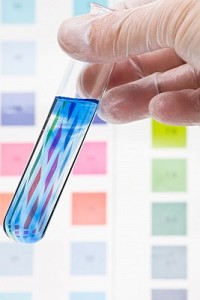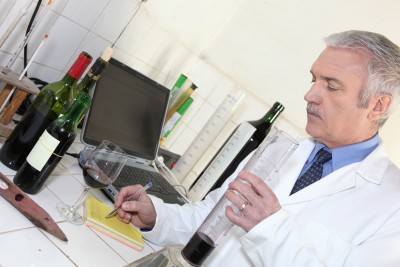Organic winemakers with ambition and conviction want to intervene as little as possible in the winemaking process in the cellar. That is why they work organically in the vineyard to produce grapes that are as healthy as they are ripe. Only from healthy grapes can must be pressed that does not require any intervention in the cellar. In the vineyard, these winegrowers work for a different physiology of their vines, which enables them to have a low pH value in the cellar. They taste it through experience already in the grape and therefore often harvest earlier than conventional winemakers or oenologists who harvest according to sugar content or total acidity. For committed, quality-oriented winegrowers, whether organic or conventional, the pH value has become an important parameter for the taste quality, digestibility and microbiological stability of their wines.
The pH value is a measure of acids and bases in an aqueous solution such as grapes or wine. Its values range from 0 = strongly acid to 14 = strongly alkaline. Water is neutral and has pH 7. In wine, the lower the pH value, the more stable and healthy the wine. The higher the pH value, i.e. the lower the acidity, the more attention must be paid to microbiology, digestibility and stability. In wine, the pH value ranges between 2.9 and 4.0, depending on the grape variety, rootstock, growing region and grape ripeness.
 |
| The pH value can be determined with the help of simple tests% often using a colour scale%. |
Even the colour of a red wine allows statements to be made about its pH value: the higher the pH value, the more a wine tends to have a bluish hue. Wines with a high pH value, i.e. low acidity, have to have their colour fixed by additives, as in modern Bordeaux, for example, or, like Australians or Beaujolais, they have deep-dark colour pigments that appear blue but are not stable. The pH value controls the energy metabolism of the yeasts during alcoholic fermentation and therefore decides on the stability and development ability of a wine. Its value signals to the cellar master whether viticultural interventions or additive treatments appear necessary.
Tartaric acid, malic acid and citric acid are dominant in the grape. Other acids such as acetic, butyric, lactic and succinic acid are formed in must and wine during alcoholic fermentation and ageing in the cellar. Their harmonious interaction with sugar and alcohol content gives a good wine the feeling of freshness and structure in the mouth. Together with the extract and concentration of the wine, this creates a mouthfeel that makes wine quality literally tangible.
Low pH is not about "sour wines"! It is about high-quality fresh, pleasant mouthfeel. When wine analyses indicate the acid value, it is the so-called titratable total acidity. Winegrowers like to give this value because it says something about the palatable acidity of a wine. However, this has nothing to do with the pH value, because the tartaric acid, which dominates the wine, as well as the citric acid, lower the pH value significantly more than the aggressively tasting malic acid, lactic acid or succinic acid. This is why the pH value as the sum of all acids is much more meaningful for the assessment of wine quality in terms of taste, as it enables statements to be made about the overall sensory quality of a wine via the mouthfeel, i.e. about its freshness, length or structure, which go far beyond "acidity" and "taste".
The pH value is decisive for the biochemical and microbiological stability of a wine, and thus also for its digestibility. It is at its lowest in the grape shortly before it begins to ripen, and rises with maturity. While the aggressive malic acid "breathes away" as the grape ripens, the production of tartaric acid stops when the cell tissue of the berry is ripe. From the sensory assessment of this balance (analysis of the chewed berries and seeds), the experienced winemaker determines the timing of his harvest and can thus decisively influence the character and style of his wines - if he masters it. The hotter a vintage, the stronger and earlier the onset of malic acid respiration, which can lead to a tired and flabby taste impression, with correspondingly poor ageing potential.
 |
| The pH value is also important in the cellar% because it is decisive for the quality and stability of the wine. |
Finally, in the cellar, the pH value is decisive for the health of the must, because hardly any bacteria can survive in an acidic environment, except for the acetic acid and lactic acid bacteria, which can, however, be tackled with sulphur dioxide if it seems necessary. The pH value is therefore an important parameter not only for the taste and biochemical quality of a wine, but also for its digestibility.
However, more and more people report headaches after drinking wine - especially after drinking red wine. And even after drinking white wine, there are more and more people, especially women, who complain of headaches and even migraines. The reactions to wine are manifold, ranging from a blocked or runny nose to a dry mouth or respiratory complaints to bronchial asthma. There are reports of cardiac arrhythmias leading to sleepless nights, of low blood pressure with corresponding fatigue and signs of exhaustion, of stomach and intestinal complaints as well as itching and reddened skin.
It doesn't take long to get to sulphur, because "sulphur in wine gives you a headache", "sulphured wine cannot be good wine", "only bad winegrowers sulphurise their wine" - there is nothing about wine that is the subject of more rumours and more worn-out clichés than sulphur. But even a dose of alcohol that is simply too high can cause headaches. After all, alcohol is a cell poison. But the complaints described above are rarely caused by alcohol alone, nor can they be attributed to the sulphur in the wine, which, except in piss-poor cheap wines that are made up of thousands of individual batches, or in the wine itself, is not present.
or in unsuccessful exceptional wines in the most negative sense, sulphur is not relevant to the health of wine. For a few years now, we have known where the complaints come from, and intensive research has been conducted into their origin and effect: it is about biogenic amines. The International Organisation of Vine and Wine (OIV) in Paris and the EU are already discussing limit values for biogenic amines in wine, which is why one has to be surprised that the wine industry, vintners as well as traders, remain silent on this topic or have obviously not even noticed it yet.
 |
| Biogenic amines are often responsible for headaches the "day after". |
Biogenic amines are protein degradation products. They are natural components in many foods, especially in matured cheese, wine, beer, there especially in wheat beer, in sauerkraut and, in high doses, in fish products and salami. The most common food intolerance caused by biogenic amines relates to the well-known histamine, but it is not the only amine that affects sensitive individuals, as some amines trigger synergistic effects. In wine, biogenic amines are well documented. They are already present in the grapes, but are mainly and persistently produced during fermentations and also vary greatly according to the chemistry of the wine, the type of fermentation and the ageing in the cellar.
Histamine is actively formed in the human body and is involved in the control of various bodily functions such as gastric juice secretion, cell growth and cell differentiation. Those who react to histamines are not allergic, but are then called histamine intolerant. For years, medical statistics have noted a significant increase in this particular intolerance, which, in addition to elevated histamine levels, also diagnoses a lowered diamine oxidase (DAO). This is a sensitive endogenous enzyme that can be inhibited in its effect by biogenic amines, alcohol and its degradation product acetaldehyde. The enzyme that causes the degradation of alcohol in the body, the so-called alcohol dehydrogenase (ADH), competes with other enzymes for the required oxygen. When alcohol and biogenic amines are ingested at the same time, the degradation of the alcohol has priority and histamine begins to accumulate in the body. Thus, the toxic effect of alcohol is intensified by biogenic amines, here especially histamine.
Although wine usually contains small amounts of histamine compared to cheese, raw sausage and fish (there is already a histamine limit for fish in the EU), it is most often cited as a trigger for the above-mentioned complaints. There are many reasons for this. Firstly, the absorption of histamine from liquids is much faster and more concentrated than from solid food. Secondly, alcohol increases the permeability of the intestinal wall, so that the histamine from the wine enters the bloodstream unmetabolised with the histamine from the food consumed at the same time. The simultaneous consumption of alcohol and histamine-rich foods such as cheese and salami with red wine can therefore quickly lead to said complaints in predisposed people. Crustaceans and certain white wines, e.g. Chardonnay from the barrique, are also considered to guarantee complaints, because crustaceans, like strawberries or citrus fruits, can spontaneously release histamine in the body.
Climate change has led to earlier ripening with better ripened grapes. This leads to faster degradation of malic acid in the grape and thus to higher pH values. At the same time as climate change, taste habits have changed, partly due to Robert Parker's influence, towards a flavour with mild, soft acidity, a rich, almost sweet body and as black a colour as possible. This is achieved by extremely late harvesting with very high pH values, which must be compensated for later in the cellar by acidification, with prolonged maceration, which in turn leads to deacidification through tartaric precipitation, as well as by biological acid reduction, which is standard for red wine, but is increasingly also practised in white wines for mild acidity. The high pH values typical of fashionable tastes promote the proliferation of bacteria because the microbial effect of the sulphur dioxide decreases exponentially. In the past, the threshold of pH 3.4, above which the proliferation of harmful bacteria begins, was hardly reached, but today there are hardly any red wines with lower pH values, and many white wines are also above this. The harmful bacteria are the main producers of biogenic amines. In the warm climate zones of the EU and all non-European wine countries, pH values that are too high may be "corrected" by systematic acidification and thus artificially adjusted to safe protection against harmful bacteria. In Northern Europe, this is only allowed to winemakers with explicit permission.
 |
| The histamine content in wine can be determined in the laboratory. |
Numerous studies on biogenic amines in wine have shown that not only the type and duration of vinification, but also climate and nutrient supply, and even the grape variety have an influence on the concentration of polyamines. Histamine, the most harmful amine, is only present in low concentrations in the initial must. Its formation takes place during the main fermentation, but even more so during the biological acid reduction, as well as during the ripening phase in the cellar. Bacteria on the grapes and incorrect microflora in the wine cellar can lead to contamination with harmful lactic acid bacteria, but certain wild yeasts that multiply in the early phase of alcoholic fermentation can also produce histamine, which is why knowing the right yeast strains is as important as "healthy" pH values in must and wine for spontaneous fermentation operations.
Guaranteed histamine-free wines would be a horse cure for the wine that nobody wants: strong must pre-clarification, inoculation with pure-bred yeast, cold rapid fermentation and then strong fining with special bentonites. Such wines would be guaranteed to be digestible - but their taste quality would be questionable.